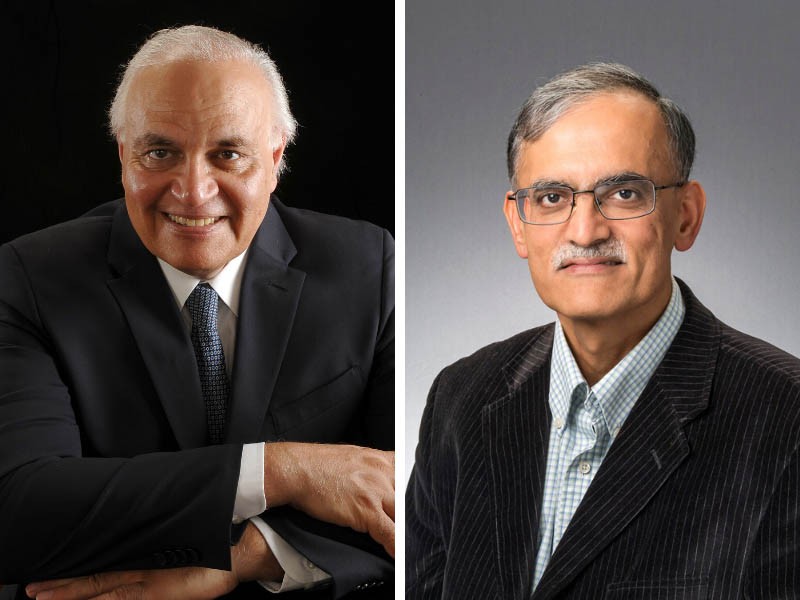Villanova Receives Funding for COVID-19 Response Through Manufacturing Innovation Challenge

Drs. Moeness Amin and C. Nataraj
Two Villanova University College of Engineering initiatives were among seven projects at four Pennsylvania universities to be awarded $174,603 in new funding through the Manufacturing PA Innovation Program COVID-19 Challenge to address the commonwealth’s response to the COVID-19 pandemic. Dr. Moeness Amin, director of the Center for Advanced Communications, received $24,802 for “COVID-19 Risk Monitoring by Wearable Sensor with Machine Learning Processing on Mobile Device.” A second $24,815 grant was awarded for “Design and Development of NovaVent,” a low-cost, rapidly manufacturable ventilator under the leadership of Dr. C. Nataraj, director of Villanova’s Center for Analytics of Dynamic Systems.
COVID-19 Risk Monitoring by Wearable Sensor
In Pennsylvania, a large percentage of the COVID-19-related deaths have occurred in residents in nursing or personal care homes. In many cases, by the time an individual becomes aware of and recognizes any single or multiple COVID-19 symptoms, they are already in danger of permanent health damage or death. In this respect, an accurate, easy-to-use capability to monitor at-risk individuals for early signs of COVID-19 infection is urgently needed.
In partnership with RTM Vital Signs, LLC, this project under the leadership of Dr. Amin aims at developing a full monitoring system that consists of an integrated sensor and smartphone application, which will work as follows:
- The sensor accurately measures the individual’s temperature, heart rate, oxygen saturation and tracheal sound.
- The mobile device receives these data wirelessly, and through an app, executes effective signal processing algorithms and machine learning techniques to extract the respiratory rate and classify the individual’s breathing conditions and disorders.
- The app computes a risk-index-score that produces a series of alerts/alarms (visual, auditory, and vibratory) that warn the patient and/or medical professional of worsening pulmonary function.
Dr. Amin notes that the sensor itself was recently developed by RTM for opioid overdose detection using an acoustic sensing modality and has since been modified and extended to include temperature and oxygen saturation markers that underlie the COVID-19 infection. RTM’s CEO and co-founder is Dr. Nance Dicciani ’69, a Villanova Chemical Engineering graduate and former member of the Villanova University Board of Trustees.
Design and Development of NovaVent
Mechanical ventilation is a critical element in treating many patients who are affected by the COVID-19 virus. With an interdisciplinary team of engineering and medical specialists, Villanovans designed and fabricated a functional, first generation prototype of NovaVent, a low-cost (<$1K), open source ventilator that operates in a mode of continuous mandatory ventilation (CMV) intended for patients who are incapable of breathing on their own.
With funding through the COVID-19 Challenge grant, the team intends to build on its preliminary design and pursue research to design NovaVent 2.0. This second iteration will be capable of more sophisticated modes of ventilation and will integrate additional control mechanisms and features more commonly found in expensive high-end ventilators. The Villanova team will then work with Pennsylvania manufacturers to produce near commercial grade components for NovaVent and engage Geisinger Health System for medical input. Testing will be conducted on the breathing simulator at CHOP and validated at Emergency Care Research Institute (ECRI), both of which agreed to offer their services at no-cost to this project. Dr. Nataraj adds, “We will also explore opportunities to distribute NovaVent to international locations through our network of service organizations.”
In a press release issued by the Department of Community and Economic Development, PA Governor Tom Wolf said: “We are fortunate to have some of the brightest minds in our higher education system, and they rose to the challenge in supporting our commonwealth during this unprecedented time. My administration remains committed to identifying new resources that can support our state’s businesses and communities as we continue to navigate this pandemic and the recovery steps ahead.”
